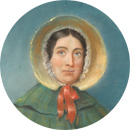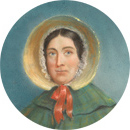
|
| Studies of a specimen of the head, operculum and scales of the fossil fish Tetragonolepis Leachii Agassiz, by Charles Weber, [1835], created as part of the research for Louis Agassiz's publication 'Recherches sur les Poissons Fossiles', (1833-1843/1844). The specimen, which was from Charlotte Murchison's collection, was found in Lyme Regis. When or from whom it was acquired is unknown. Archive ref: LDGSL/613/2/57 |
Charlotte Murchison had spent the two weeks when her husband travelled along the coast alone, sketching and fossil hunting with Mary Anning. From then on during the Murchisons’ geological trips, Charlotte would be the one tasked with finding fossils, building up her own, important palaeontological collection. The two women remained friends and corresponded frequently, with Charlotte acting as a go between for Fellows of the Society who wished to purchase fossils from Anning.
This extract of a letter from Anning to Charlotte shows how this relationship worked, as well as how dangerous fossil hunting with Anning could be.
"Dear Madam
I have defered answering your kind letter to the last moment in hope that I should have been able to have accepted your kind invitation1, but I am obliged to say that I cannot do so. To say how much I am dissappointed would be needless, independant of the honour of being invited to your house I have never been out of the smoke of Lyme - as my journey to London depended on a letter and I have not yet received it. I no longer hope to receive by the time specified in yours I can truly say that hope deffered maketh the heart sick. I have taken the liberty to send you a few specimens which I hope you will do me the honour to accept of, the shells are all from the Cowstone of the green Sand Mr Sowerby2 must name them for you and also the Ammonites.
Since I wrote to you I have not found much I soone lost the green sand mania3 and returned to my old passion for bones, the other day having found a part of a plesiosaurus I so intent in getting it out that I had like to have been drowned and the man I had employed to assist me, after we got home I asked the man why he had [not] cautioned me about the tide flowing so rapidly he said I was ashamed to say I was frightened when you didn't regard it, I whish you could have seen us we looked like a couple of drowned rats, so woebegone it makes me cold [to] think of it. 4
 I have got a very good head of an Ichthyo vulgaris about two feete in length which I value at five £ - and this day I have found a beautiful Ammonites Obtusus about a foote across which I value at one pound, pray do you think it will do for Mr Lyle5 if so Madam you will have the kindness to write me word, I will send immeadtly - in regard to the round vegetable which you say Mr Konig would like to see a sketch of he can see it at the Engravers for the Geological Society has [it].6 Mr De la Beach paper will soone be out on the lias and Marle, you will [see] both that and the other forms figured be pleased Dear Madam to accept of mine and my Mothers most Grateful thanks for all your kindness
I have got a very good head of an Ichthyo vulgaris about two feete in length which I value at five £ - and this day I have found a beautiful Ammonites Obtusus about a foote across which I value at one pound, pray do you think it will do for Mr Lyle5 if so Madam you will have the kindness to write me word, I will send immeadtly - in regard to the round vegetable which you say Mr Konig would like to see a sketch of he can see it at the Engravers for the Geological Society has [it].6 Mr De la Beach paper will soone be out on the lias and Marle, you will [see] both that and the other forms figured be pleased Dear Madam to accept of mine and my Mothers most Grateful thanks for all your kindness
and believe me your obliged
humble servant
Mary Anning"
[Extract of a letter from Mary Anning to Charlotte Murchison, 25 February [1829] (Archive ref: LDGSL/838/A/7/1)]
The letter ends with Anning professing a longing "to peep" into Murchison's fossil cabinet "more especially to examine his bones" . This sounds to modern ears rather salacious, but Anning was certainly dazzled by her meetings with Murchison. In another letter to Charlotte from October 1833 she states:

"Dear Madam you did not send me Mr Murchison's last anniversary speech,7 I long to see it for Mr Hutton told me it was the best he had ever heared and that Mr Murchison looked like a God when he made it, which I most cordially believe for Mr Murchison is certainly the handsomest piece of flesh and blood I ever saw..." Extract from a letter to Charlotte Murchison, 11 October [1833], Archive ref: LDGSL/838/A/7/3.
Notes:
1. Anning did eventually visit London between 7-12 July 1829 and was shown around the Geological Society's Museum by its curator William Lonsdale.
2. The natural history illustrator and naturalist James Sowerby (1757-1822, GSL membership no.71). Original author and illustrator of 'Mineral Conchology of Great Britain' [1812]-1846.
3. Anning's 'Green Sand Mania' involved her and her friend Elizabeth Philpot (a fellow female fossil collector from Lyme) beating the very hard Cowstone concretions found in the Greensand strata to break them open to look for fossils which she refers to earlier in the letter.
4. This was not the only near miss she had when fossil hunting. In a letter to Charlotte dated 11 October [1833], she states: "Perhaps you will laugh when I say that the death of my old faithful dog quite upset me, the Cliff fell upon him and killed him in a moment before my eyes, and clost to my feet, it was but a moment between me and the same fate." [Letter from Mary Anning to Charlotte Murchison, 11 October [1833] (Archive ref: LDGSL/838/A/7/3)]
5. The geologist Charles Lyell (1797-1875, GSL membership no.498).
6. Anning is likely referencing the plates which were produced for William Buckland’s paper “On the Cycadeoideæ, a Family of Fossil Plants found in the Oolite Quarries of the Isle of Portland", published in the Transactions of the Geological Society of London’, series 2, vol 2 (1829) pp395-401. The plate of the fossil referred to by Anning wasn’t included, but it is thought to have been published in William Hutton’s & John Lindley’s ‘Fossil flora of Great Britain’ (1831-1837) vol 2, no.143.
7. The particular Anniversary Address, made by Murchison as President of the Society, included a reference to Anning herself - her discovery of the large Ichthyosaurus platydon which was acquired by Thomas Hawkins (see: 'Sea Dragons' in the exhibition)
<<Back
Next: Pterosaurs, coprolites and sepia>>